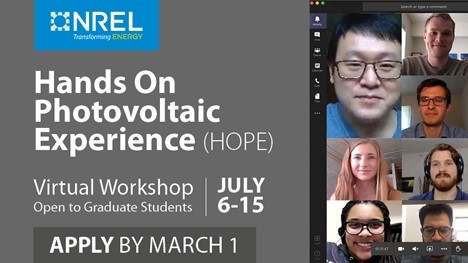Top News: Solar-Plus-Storage Webinar Series; Homebuilders Guide;
The U.S. Department of Energy (DOE) announced new leadership; DOE’s Solar Energy Technologies Office (SETO) is getting webinar-ready, with a two-day series highlighting projects that integrate solar with storage and demand response, as well as our first stakeholder webinar of the year; apply to work with researchers at the National Solar Thermal Test Facility; and check out our updated solar guide for homebuilders, a new report on solar costs, and progress on standards for photovoltaics (PV).
Read these stories and more in this edition of the SETO newsletter.
New Leadership
We would like to welcome Kelly Speakes-Backman as our new principal deputy assistant secretary and acting assistant secretary for the Office of Energy Efficiency and Renewable Energy (EERE). She brings more than 20 years of experience in energy and environmental work to the role. Learn more about DOE’s new EERE team.
Solar-Plus-Storage Projects: See How They’ve Grown
Join DOE February 25 and 26 at 12 p.m. ET for a webinar series showcasing projects that examine how to connect renewable power with storage and demand response. Many of these projects were launched in 2016, as part of the Sustainable and Holistic Integration of Energy Storage and Solar PV (SHINES) program. Now we’re taking a look at that research to see what utilities, researchers, and other solar industry stakeholders can learn about integrating these technologies and how it can help pave the way for more solar deployment on the grid. Register today to learn more about these projects.
Work with a National Lab to Advance Concentrating Solar-Thermal Power (CSP)
Sandia National Laboratories is seeking proposals for one-year projects to support CSP technologies at the National Solar Thermal Test Facility (NSTTF) in Albuquerque, NM. Areas of interest include receiver and heat-exchanger testing, various component evaluations, solar-thermochemical processes, and more. SETO will fund up to $1 million for up to five awards, ranging from $150,000 to $500,000. Learn more and apply by March 1.
Next Stakeholder Webinar: The Future of Solar
Join SETO Director Dr. Becca-Jones Albertus and guests as they discuss how DOE’s solar investments will help to achieve ambitious decarbonization goals on March 25 at 3 p.m. ET. Topics will include priorities for the coming year and what lies ahead for solar research and development. We’ll also answer your questions, so send yours to solar@ee.doe.gov. Register today.
Why Homebuilders Should Add Solar—and How
The benefits of solar extend to those who build houses. New homes with solar-ready roofs give homebuilders a competitive advantage, create interest for consumers who want lower utility bills, provide financial incentives, and more. You can read about them in the newly updated Solar Energy Guide for Homebuilders, which also lists important considerations during the building process, including interconnection, battery storage, and electric vehicle charging, making the process checklist-friendly.
SETO Is Hiring
Come be a part of the clean energy future with DOE. We’re looking for a technology manager on our Systems Integration team and a program manager for our Manufacturing and Competitiveness team. The technology manager will be responsible for coordinating, implementing, evaluating, and managing research and development projects that explore planning and operation, solar-plus solutions, and more. The program manager will be responsible for budgeting, planning, evaluating projects that move groundbreaking, early-stage solar technology concepts closer to market, and managing a team. Apply today.
Calling All Grad Students for a Virtual National Lab Experience
The National Renewable Energy Laboratory (NREL) is seeking graduate students for the 10th annual Hands-On Photovoltaic Experience (HOPE) workshop this summer. Students selected to participate in the virtual event, held July 6–15, will get to interact with scientists at NREL, learn about PV technology in a hands-on setting, and build a network of research connections across the United States. NREL is accepting applications until March 1 at 7 p.m. ET. Learn more and apply.
 The New Solar Installation Costs
NREL recently released a benchmark report establishing the costs of installing PV and solar-plus-storage systems, based on national averages. Over the past decade, costs have dropped by more than 60% across residential and commercial scales and more than 80% at the utility scale, largely because of decreased module prices. Find out what it will take to lower costs further, and register for the February 24 webinar to hear the authors discuss their findings.
Standard Progress for Inverter-Based Resources
An Institute of the Electrical and Electronics Engineers (IEEE) working group approved a preliminary draft of the new P2800 standard—a critical first step toward approval from the IEEE Standards Association to implement formal technical performance requirements for inverter-based resources (IBR), like solar PV, that are interconnected to the grid. Much like its predecessors (IEEE 1547 and 1547.1), the P2800 standard addresses the interconnection performance requirements of larger IBR facilities and is designed to help manufacturers, generation project developers, transmission planners, and power grid operators improve the quality of the inverter and facility performance of large-scale solar plants. SETO has funded NREL, Sandia National Laboratories, and Electric Power Research Institute efforts to facilitate this standard’s development with the North American Electric Reliability Corporation and other stakeholders. Learn more about the new standard.
|